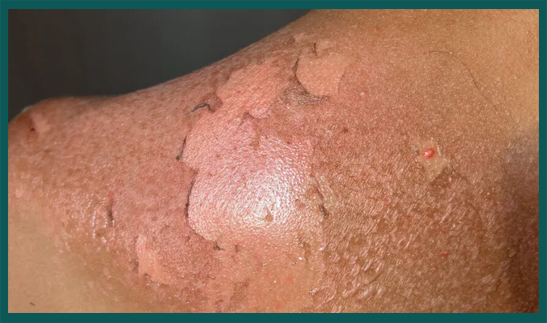

TOXIC EPIDERMAL NECROLYSIS
Toxic epidermal necrolysis (TEN) is a medical emergency, as the extensive mucocutaneous blistering is associated with a high mortality rate. The patient becomes systemically unwell and often pyrexial, and erythema and blistering develop, initially on the trunk but rapidly involving all skin. Sheets of blisters coalesce and denude, and the underlying skin is painful and erythematous. Mucous membrane involvement and blistering are usual.
A disease severity score is used to predict outcome. The main differential diagnosis is SSSS although the diagnosis is usually obvious in an adult patient with a culprit drug. Skin snip allows early diagnosis and is preferred to full-thickness skin biopsy in the acute stage. Identification and discontinuation of the causative drug are essential. Intensive care in a dedicated dermatology ward or intensive care or burns unit is of paramount importance.
SYMPTOMS OF TOXIC EPIDERMAL NECROLYSIS
Symptoms may include:
TREATMENT OF TOXIC EPIDERMAL NECROLYSIS
Treatment is supportive, with
HOMOEOPATHIC TREATMENT
Belladonna: is one of the first remedies that comes to one's mind when inflammation is encountered – inflammation with its redness, swelling, pain, throbbing and burning-when suppuration, maybe, is commencing. The affection comes on suddenly and with great violence. There are painful, hot, shining, erysipelatous swellings, intensely inflamed about their bases.
Crotalus horridus : another snake poison, may be of use in certain suppurating conditions, but when it is called for the picture is indeed a horrible one. With a typical Crotalus patient, you will feel that death is very near. And with these patients, death generally does come so quickly – the entire system is so terrifically affected – that no part has had time to suppurate or resist. Boils, carbuncles and eruptions are surrounded by a purplish condition of the skin, a mottled, blue, splotched or marbled state. It produces boils, abscesses and a condition resembling a carbuncle, with burning and violent pains, but the characteristic feature is the doughy centre. Around the boil or carbuncle for many inches there is edema, with pitting upon pressure; and the boil, or carbuncle for many inches there is edema, with pitting upon pressure; and the boil, or abscess, or carbuncle, will bleed a thick, black blood that will not coagulate.
Rhus toxicodendron : is a plant poison and might appropriately be mentioned at this time. When it is needed you will recognise it by its one grand prevailing characteristic-aggravation from rest and relief from motion. It gets its other leading indications- dark red, angry, edematous, erysipelatous swellings and eruptions, its great prostration, heat and burning, from its malignant septic and toxic states.
Arsenicum album: a mineral poison, is regarded by many as the chief remedy for carbuncle. It is almost synonymous with gangrene, yet has suppuration.
It will be of use many times, in the treatment of malignant, septic, suppurating disturbances, and you will know it when it is needed, by its pronounced characteristics-great weakness and prostration, burning everywhere-as if live coals were on the affected part, pains worse at rest and increased by cold, restlessness and anguish (here restlessness is not to relieve pain, as with Rhus, but from anxiety), midnight aggravation, unquenchable thirst for small quantities of water very often, and great irritability of mind and body.
Echinacea: the corrector of blood dyscrasia, although a fairly new remedy, is a valuable one. It is of value in acute auto- infections, septic conditions with lymphatic involvement, for abscesses and carbuncles associated with great loss of strength, and for obstinate scrofulous and syphilitic diseases, for which it may be used both locally and internally. It may be indicated in conditions that come from crushing injuries, where the tissues have lost their resistance. It promotes localisation and pus formation.